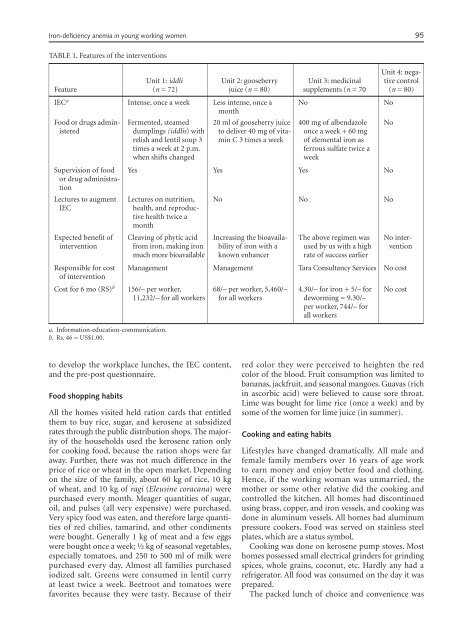F&N Bulletin Vol 23 No 1b - United Nations University
F&N Bulletin Vol 23 No 1b - United Nations University
F&N Bulletin Vol 23 No 1b - United Nations University
Create successful ePaper yourself
Turn your PDF publications into a flip-book with our unique Google optimized e-Paper software.
Iron-deficiency anemia in young working women<br />
95<br />
TABLE 1. Features of the interventions<br />
Unit 4: nega-<br />
Unit 1: iddli Unit 2: gooseberry Unit 3: medicinal tive control<br />
Feature (n = 72) juice (n = 80) supplements (n = 70 (n = 80)<br />
IEC a Intense, once a week Less intense, once a<br />
month<br />
Food or drugs administered<br />
Supervision of food<br />
or drug administration<br />
Lectures to augment<br />
IEC<br />
Expected benefit of<br />
intervention<br />
Responsible for cost<br />
of intervention<br />
Cost for 6 mo (RS) b<br />
Fermented, steamed<br />
dumplings (iddlis) with<br />
relish and lentil soup 3<br />
times a week at 2 p.m.<br />
when shifts changed<br />
20 ml of gooseberry juice<br />
to deliver 40 mg of vitamin<br />
C 3 times a week<br />
<strong>No</strong><br />
400 mg of albendazole<br />
once a week + 60 mg<br />
of elemental iron as<br />
ferrous sulfate twice a<br />
week<br />
Yes Yes Yes <strong>No</strong><br />
Lectures on nutrition,<br />
health, and reproductive<br />
health twice a<br />
month<br />
a. Information-education-communication.<br />
b. Rs. 46 = US$1.00.<br />
Cleaving of phytic acid<br />
from iron, making iron<br />
much more bioavailable<br />
<strong>No</strong><br />
<strong>No</strong><br />
<strong>No</strong> <strong>No</strong> <strong>No</strong><br />
Increasing the bioavailability<br />
of iron with a<br />
known enhancer<br />
The above regimen was<br />
used by us with a high<br />
rate of success earlier<br />
<strong>No</strong> intervention<br />
Management Management Tara Consultancy Services <strong>No</strong> cost<br />
156/– per worker,<br />
11,<strong>23</strong>2/– for all workers<br />
68/– per worker, 5,460/–<br />
for all workers<br />
4.30/– for iron + 5/– for<br />
deworming = 9.30/–<br />
per worker, 744/– for<br />
all workers<br />
<strong>No</strong> cost<br />
to develop the workplace lunches, the IEC content,<br />
and the pre-post questionnaire.<br />
Food shopping habits<br />
All the homes visited held ration cards that entitled<br />
them to buy rice, sugar, and kerosene at subsidized<br />
rates through the public distribution shops. The majority<br />
of the households used the kerosene ration only<br />
for cooking food, because the ration shops were far<br />
away. Further, there was not much difference in the<br />
price of rice or wheat in the open market. Depending<br />
on the size of the family, about 60 kg of rice, 10 kg<br />
of wheat, and 10 kg of ragi (Eleusine coracana) were<br />
purchased every month. Meager quantities of sugar,<br />
oil, and pulses (all very expensive) were purchased.<br />
Very spicy food was eaten, and therefore large quantities<br />
of red chilies, tamarind, and other condiments<br />
were bought. Generally 1 kg of meat and a few eggs<br />
were bought once a week; ½ kg of seasonal vegetables,<br />
especially tomatoes, and 250 to 500 ml of milk were<br />
purchased every day. Almost all families purchased<br />
iodized salt. Greens were consumed in lentil curry<br />
at least twice a week. Beetroot and tomatoes were<br />
favorites because they were tasty. Because of their<br />
red color they were perceived to heighten the red<br />
color of the blood. Fruit consumption was limited to<br />
bananas, jackfruit, and seasonal mangoes. Guavas (rich<br />
in ascorbic acid) were believed to cause sore throat.<br />
Lime was bought for lime rice (once a week) and by<br />
some of the women for lime juice (in summer).<br />
Cooking and eating habits<br />
Lifestyles have changed dramatically. All male and<br />
female family members over 16 years of age work<br />
to earn money and enjoy better food and clothing.<br />
Hence, if the working woman was unmarried, the<br />
mother or some other relative did the cooking and<br />
controlled the kitchen. All homes had discontinued<br />
using brass, copper, and iron vessels, and cooking was<br />
done in aluminum vessels. All homes had aluminum<br />
pressure cookers. Food was served on stainless steel<br />
plates, which are a status symbol.<br />
Cooking was done on kerosene pump stoves. Most<br />
homes possessed small electrical grinders for grinding<br />
spices, whole grains, coconut, etc. Hardly any had a<br />
refrigerator. All food was consumed on the day it was<br />
prepared.<br />
The packed lunch of choice and convenience was
















